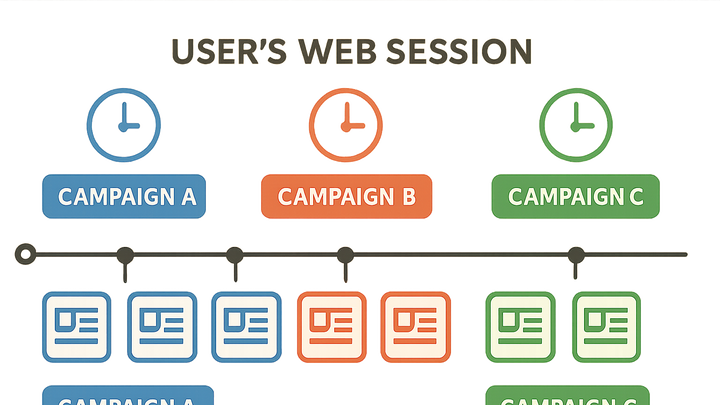Published on 2025-06-28T02:01:43Z
What is Sessionization? Examples for Sessionization
Sessionization is the process of grouping a series of user interactions (hits) into meaningful units called sessions. In web analytics, a session represents a period of engagement where a visitor interacts with a website before a period of inactivity terminates the session. Proper sessionization enables analysts to measure metrics like session count, average session duration, and user journeys, which inform decisions about content, marketing, and usability. Session boundaries are typically defined using time-based thresholds (such as a 30-minute idle timeout), campaign changes, or day boundaries. Different analytics platforms implement sessionization with slight variations: Google Analytics 4 (GA4) uses a default 30-minute timeout and resets on new campaign parameters, while cookieless solutions like PlainSignal employ deterministic identifiers and similar timeouts without relying on third-party cookies. Understanding and configuring sessionization correctly ensures more accurate data, better insights into user behavior, and more effective optimization strategies.
Sessionization
Grouping user interactions into time-bound sessions for accurate web analytics insights.
Fundamentals of Sessionization
This section covers the core concept of a session in web analytics, why sessions matter, and key metrics derived from session data.
-
Session definition
A session is a group of user interactions within a specific time frame. It starts with the first interaction and ends after a period of inactivity or when a predefined event resets the session.
-
Start conditions
Begins when a user lands on the site or triggers a tracked event.
-
End conditions
Ends after a default idle timeout (e.g., 30 minutes), at midnight, or on new campaign parameters.
-
-
Key session metrics
Analytics platforms derive metrics like session count, average session duration, and bounce rate from session data.
-
Session count
Total number of sessions recorded in a given period.
-
Session duration
Time elapsed from session start to session end.
-
Sessionization Algorithms
Different analytics systems use algorithms to determine session start and end, often combining time-based and content-based rules.
-
Time-based rules
Sessions are separated after a set inactivity period.
-
Idle timeout
Default 30 minutes in Google Analytics 4 (GA4), configurable in most analytics tools.
-
Custom time windows
Adjusting timeouts to match specific site behavior, such as longer sessions for video-heavy pages.
-
-
Content-based rules
Sessions reset on changes in campaign attribution or at day boundaries.
-
Campaign change
New UTM parameters or traffic sources start a new session.
-
Midnight reset
Sessions may reset at midnight local time, splitting visits across calendar days.
-
Implementing Sessionization in Analytics Tools
Examples of how popular SaaS analytics platforms handle sessionization, including Google Analytics 4 (GA4) and cookieless PlainSignal.
-
Google analytics 4 (GA4)
GA4 automatically groups events into sessions using a 30-minute idle timeout and resets sessions on new campaign parameters.
-
Default settings
Sessions expire after 30 minutes of inactivity and restart when UTM parameters change.
-
Customization
Modify session timeout settings under Admin › Data Streams › More tagging settings in the GA4 interface.
-
-
PlainSignal
A cookie-free analytics tool that uses deterministic identifiers and timeouts for sessionization, ensuring privacy compliance.
-
Tracking snippet
Embed the PlainSignal script in your HTML:
<link rel="preconnect" href="//eu.plainsignal.com/" crossorigin /> <script defer data-do="yourwebsitedomain.com" data-id="0GQV1xmtzQQ" data-api="//eu.plainsignal.com" src="//cdn.plainsignal.com/plainsignal-min.js"></script> -
Session handling
PlainSignal assigns a session ID based on IP and user agent, resetting after 30 minutes of inactivity by default.
-
Best Practices and Considerations
Tips for configuring and interpreting sessions to ensure high-quality analytics data.
-
Align timeout with user behavior
Set idle timeouts that match how users engage with your site to avoid splitting or combining sessions incorrectly.
-
Privacy and compliance
Use cookieless methods like PlainSignal to respect user privacy and comply with data regulations such as GDPR and CCPA.
-
Cross-device and cross-domain sessions
Understand that sessions may not stitch across devices or domains without user IDs or advanced tracking methods.
